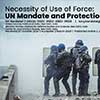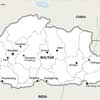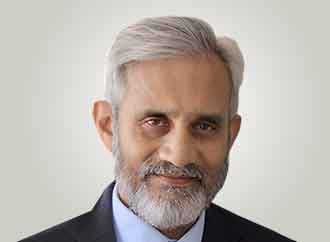Abstract
The legacy of the Indo-Bhutan relationship goes back by many centuries which has been only
growing after India's independence. However, Bhutan getting closure to demarcating its disputed boundary with
China is perceived in India as Bhutan compromising India's security despite their years of close relationship.
This article argues that geopolitical and internal compulsions of Bhutan and India's obsession with the People's
Liberation Army's threat to the Siliguri Corridor has brought both India and Bhutan into an irreversible situation
leaving no option for India other than encouraging Bhutan to solve its boundary dispute as early as possible.
Introduction
The Indo-Bhutan relationship is the legacy of Bhutan's relations with Britain when Bhutan first clashed with the
colonial power in 1865 and later when the British signed the Punakha Treaty in 1910. This treaty laid the foundation
for the Indo-Bhutan strategic partnership which further evolved after India's independence in 1947.1 Bhutan shares
a 605 km border with India. But its 470 km border with China is disputed. Out of 764 sq km of disputed territory,
495 sq km is in the north and 269 sq km lies in the north-western sector near Chumbi Valley. Being glaciated, the
northern border with China did not draw much attention until a few years back. However, the north-western boundary
is of strategic importance to all three countries.
Despite 25 rounds of talks, Bhutan's boundary with China is yet to be demarcated. Whenever there is a boundary talk and news of a possible solution, there is speculation in Indian media about its impact on India's security. Out of all its immediate neighbours, India's relationship with Bhutan has been at its best. However, the desire of the democratic government of Bhutan to solve the boundary problem permanently seems to hint that the strategic partnership between Bhutan and India has reached a crossroads. When King Jigme Khesar Namgyel Wangchuck of Bhutan visited India from 03 to 10 Nov 2023, a section of the Indian media portrayed it as Bhutan trying to mollify India on the eve of a possible border deal with China.2 Bhutan's last Prime Minister (PM) Lotay Tshering's remarks that China and Bhutan were inching towards completing their three-step Roadmap earlier had created fear in the minds of the Indian population about a possible trade-off between Chinese claims in Doklam Plateau (located at the southern tip of Chumbi Valley inside Bhutan and nearby of the tri-junction between India, Bhutan and China) and ones in Northern Bhutan.3 The comments of the Bhutanese PM to a Belgian newspaper that it was "Not up to Bhutan alone to solve the border problem. There are three of us" were perceived negatively by individuals distant from the truth. Until now, even though it will be logical to conclude that decisions taken by Bhutan on the boundary talks have been in consultation with India, Bhutan has never named India officially. At the same time, China claims that "India has always been the reason for the delay in negotiations on boundary issues between China and Bhutan".4 Therefore, the Bhutanese PM's public acknowledgement of India's stake in the boundary demarcation should have drawn accolades instead of brickbats.
Such a fear, however, is not completely unfounded because firstly, crammed between two competing powers of Asia, Bhutan on one hand is strategically important to both Asian powers. On the other hand, being a small landlocked country devoid of natural resources, Bhutan's geopolitical location dictated its foreign relations and impacted India's security.5 Therefore, its destiny is linked to its big neighbours, India and China. It is hence, a geopolitical challenge for Bhutan to delicately balance its position without compromising its sovereignty, while not drawing China's ire or jeopardising its bilateral relations with India, with the background of both these neighbours having fought each other in the past. The 1962 Sino-Indian War, the border clashes in Nathu La and Cho La in 1967, the 1987 Sumdorong Chu standoff, the Doklam standoff in 2017 and the 2020-2021 skirmishes in Galwan in Eastern Ladakh could have easily upset this balance. Secondly, China had offered to forgo its claim over the disputed area in the north in exchange for the Doklam Plateau. The Doklam area is as important to China as it is to India. Straddled by India and Bhutan on either side and the narrowest point is around 20 km, Chumbi Valley is China's 'Achilles Heel'. Any increase in the size of the valley will reduce the distance between the valley and the Siliguri Corridor and will help China's People's Liberation Army (PLA) compensate for its vulnerability to some extent. India and Bhutan have always protested and tried to resist the presence of the Chinese and the PLA outside the valley.
Eyebrows were raised again when India's PM paid a state visit to Bhutan on 22 and 23 Mar 2024 just before India's national elections. According to official statements, this visit was "Keeping with the tradition of regular high-level exchanges between India and Bhutan and the government's emphasis on its Neighbourhood First Policy".6 Most other national media picked up the thread and followed the line. While a head of government visiting another country just before the all-important parliamentary elections unless it is a national emergency, is intriguing, the aim of this writing is not to find the reasons for the visit but to attach importance to the impact of the boundary demarcation on the strategic partnership between India and Bhutan. Understanding the dynamics of the Indo-Bhutan relationship will however not be complete without discussing the security concerns of India and how the common element-China, impacts this relationship.
China Factor
Bhutan's relationship with Tibet was never particularly good.7 After its independence and post the
India-China War in 1962, as India began to increase its influence in Bhutan, it caused worries for China. To dislodge India
from its space in Bhutan, China evolved a strategy, that includes solving the boundary dispute to secure the south-western
flank, establishing a diplomatic relationship, resorting to military and non-military activities like intrusion inside the
disputed areas, and increasing the scope of bilateral trade with Bhutan.
Boundary discussions have been going on since 1984 and so far, 25 rounds of boundary talks have taken place without making much headway. Both sides came up with different claims and counter-claim lines. All the claim lines of China included the Doklam Plateau. When nothing moved forward, in 1996, China offered to barter its claim over the northern sector against the north-western sector. It also wanted to shift the trijunction from Batang La to Gemoychen. Interestingly, while the talks were on, China gradually encroached inside Bhutan. Encroachment in the northern sector by and large went unnoticed as these are outside the immediate area of influence of the Indian Army. China, however, moved cautiously when it came to Doklam. What happened in Jun 2017 is now history. 8 In the northern area, which is glaciated and difficult to access, China's offer of exchange of territory was not taken seriously. But when China added spiritual content to the not-so-important disputed areas in the Northern Sector, the matrix changed. It was done by illegally occupying the Beyul region in Northern Bhutan for the settlement of Chinese Tibetans.
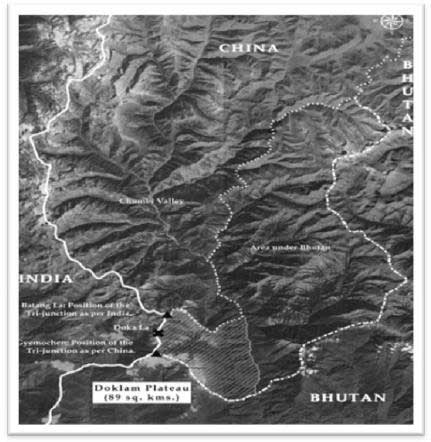
A vivid description of the Chinese project in the disputed area can be found in the research report of Barnett.9 Beyul means hidden valley and was concealed by legendary Guru (Spiritual Leader) Padmasambhava also known as Guru Rinpoche, who is considered the Second Buddha in Bhutan.10 The legend further goes that the Beyuls are only discoverable by those with heightened spiritual powers. According to local legends, Beyuls are meant for the Bhutanese to take refuge when the world comes to an end. Besides, the father of the first King of Bhutan was born in the Beyul region. Being religious, cultural and for their emotional attachment to their kings, the Beyul region is an area that the Bhutanese are not going to give up.
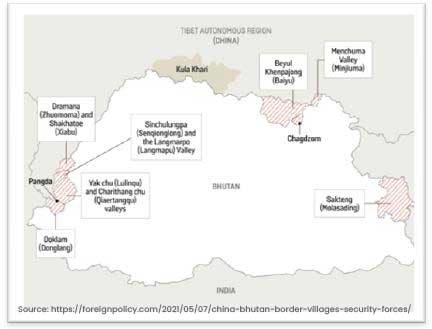
China claims this region as part of the Tibet Autonomous Region, even though it is inside Bhutan. According to Barnett, Project Gyalaphug or Beyul Khenpajong includes three new villages two already occupied, one under construction, new roads, a small hydropower station, two Communist Party administrative centres, a communications base, a disaster relief warehouse, five military or police outposts, a satellite receiving station, a military base, and up to six security sites and outposts. Incidentally, the work for this village began five years earlier than Pagda village, which came up along the Amouchu River inside Bhutanese territory after the Doklam standoff. By then, work in Gyalaphug was already more than halfway through.
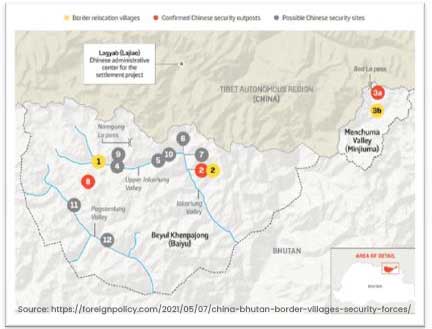
The second enclave for settlement by China in Northern Bhutan is in Menchuma Valley, around 2 km to the east of the Beyul Khenpajong. 19 square miles in size, this region is at an altitude of more than 14,700 ft and lies in the Lhuntse district. Until now, it never had settlements, roads, or buildings. The third enclave of Chinese construction is Jakarlung Valley which is west of Beyul Khenpajong.
China had set its eyes on the Beyul region as early as the mid-1950s. There are stories about Tibetan yak herders moving to Bhutan's traditional grazing ground and later claiming the generally uninhabited lands. But one story, as learned from one of the author's reliable friends in Bhutan is slightly different from what Barnett had to state.11 Four Bhutanese Tibetan families of the Beyul region were entrusted with looking after four yak herds belonging to the noble families. These families used to cross over to Tibet for grazing and were also involved in cattle rustling. Sometime later, two families or maybe all, stole the same herds, which were their responsibility to protect and moved to a village called Lagyab in Tibet. In 1995, the same herders were asked by their Chinese masters to cross over and to go and live year-round in the Beyul region along with their stolen yaks. Later, Chinese media applauded the four nomads' dedication to discovering their sacred land which had been hidden since ancient times.
The areas of the Beyul region under Chinese occupation are not very far from Bumthang, which is almost midway on Bhutan's west-east lateral and known as the cultural and religious heartland of Bhutan. Further slicing of the Bhutanese territory will present a new security threat to Arunachal Pradesh from the west. Other than the Doklam, all areas are outside the immediate area of direct influence of the Indian Army. Since Doklam has always been at the centre of discussions on the threat to the Siliguri Corridor, it needs some explanation.
Siliguri Corridor and the threat
PLA's threat to the Siliguri Corridor is not new. According to Claude Arpi, the French Tibetologist, way back in 1948, Harishwar Dayal the then
political officer of India to Sikkim stated that Chumbi Valley was a threat to India's Siliguri Corridor and, hence, India must occupy the valley.
12 Because of its geographical location, the Chumbi Valley is vulnerable to military threats from a probable collusion between India and Bhutan.
With his statement, Dayal made the PLA threat to the Siliguri Corridor and the Indian Army's threat to the Chumbi Valley public, creating fear and
leaving room for varying interpretations of the threat. It is a military compulsion for the PLA to enlarge the size of the valley as far as south
as possible to reduce the threat from the Indian Army, which is currently occupying heights on the mountains that dominate the plateau. This is
why Doklam was always part of all claims that China has made so far. As for India, shifting tri-junction is not negotiable. Was there a common point
that all three countries could agree on? The author believes that there was, but the time has passed.
As for India, the closer the enemy the bigger the threat. However, since 1948, time has changed, and the gravity of the threat is not what it was earlier. On the contrary, the PLA on the plateau is vulnerable to the Indian Army. To mitigate this threat, China either moves further south to higher heights like the Jampheri Ridge (the watershed ridge bordering India and overlooks the Siliguri Corridor) or extracts assurances from India that there will be no military invasion of the valley by establishing a diplomatic relationship and demarcating the boundary along the line where the PLA is sitting now.
It is worthwhile to share what a common Indian citizen feels about the threat to the Siliguri Corridor. Sometime back, when the author was returning from North Bengal University, Bagdogra to catch his flight from Bagdogra airport, he engaged the cab driver in a casual conversation. The driver explained to the author about the new road from Kolkata and amplified the description by highlighting the importance of the Siliguri Corridor and China's threat to it. When asked what he thought about the threat, he stated, "Aab woh time nahi raha (the old time has changed)". The citizens have faith in the Indian Armed Forces to confront any remaining threat posed by the PLA. It is a matter of pride for the man in uniform to believe in it and acknowledge it publicly. Not believing in their capability and not admitting it may mean something else.
Option for India
Even though China's offer of exchange of territory is still open, after having invested economically and militarily in the occupied areas,
such an option should not be taken seriously. Because, apart from the fact that Bhutan is not in a position to stand up to China, which has
already built its military infrastructure on the Doklam Plateau. Therefore, there is no compulsion for China to follow through with the offer
any more. What remains for Bhutan is to bargain for something else in return for the Beyul region. Besides demarcating the boundary, China's
conditions if it still wants to, can include anything from establishing a diplomatic relationship, increasing bilateral trade or even compelling
Bhutan to be a part of the Belt and Road Initiative project.
By occupying the unauthorised territories in the north-western sector, in the northern sector, along the Amochu River, and staking a claim on Sakteng Life Sanctuary, China has now checkmated India.13 The strategic pincer by China can be compared with using pressure points in the human body to either relieve pain or immobilise the body. Responding to China's strategic signal does not leave much choice to India other than preventing China from further encroachment. China has benefitted from the American playbook about strategic outmanoeuvring rather than challenging the enemy on the field.14 If war is not an option, India must encourage Bhutan to demarcate the boundary with China to avoid further compromising India's security as early as possible.
Conclusion
India and Bhutan's relationship has grown over the past decades. Bhutan has always stood by India in its difficult times and held a strong position
in support of India's security when it came to mending relations with China. The singular factor has been India's fear of the PLA threatening the
Siliguri Corridor. India's security establishment's obsession with the threat to the Siliguri Corridor has trapped India and Bhutan in a non-retrievable
situation. The presence of a threat factor helps to establish an appropriate response mechanism. But too much of it will impact the larger security
interest of the country. Besides, war-fighting has changed. The need for the PLA to physically occupy Jampheri Ridge to threaten the Siliguri
Corridor is no longer driven primarily by the aim of peering deep into Indian territory, as this can be done from a distance, using modern
technology. It is more to mitigate the threat to the PLA troops positioned on the Doklam Plateau and Chumbi Valley from the Indian Army, and force
Bhutan's hand to end the dispute by demarcating the boundary.
Despite the irreversible situation of the Indo-Bhutan partnership is now at a crossroads, is it possible to pick up takeaways for the future? There can be many. But a few important ones are:
firstly, no part of the territory or ground is not 'Strategically Not Important'. Creative use of strategy can change a seemingly unimportant ground to strategically important ground;
secondly, policy and strategy take years to evolve and hence must be pursued by successive institutions despite differences;
thirdly, the formulation of such a strategy always factors in security inputs from the uniformed community. Therefore, the inputs must be based on larger security interests and not influenced by individual needs to survive and remain relevant. For this, the uniformed community must be well-informed and well-read. This will help them provide honest input;
fourthly, as mentioned by Henry Kissinger in his book 'On China', 'Far better than challenging the enemy on the field of battle is manoeuvring him into an unfavourable position from which escape is impossible';
fifthly, if the demarcation of boundaries helps avoid war, boundaries should be demarcated provided it does not make one weaker. On the other hand, be mindful that if not demarcating the boundary makes one weaker, then demarcate the boundary post haste;
sixthly, in the context of China and India military balance, there is a need to reassess the PLA threat to the Siliguri Corridor and recommend options for optimal utilisation of the Indian Army troops currently deployed in that sector;
finally, the search question is, has India done enough to nurture and strengthen the bilateral relationship with India's immediate neighbours or does more need to be done?
India needs Bhutan more than Bhutan needs India!
Major General (Dr) A. K. Bardalai, is a former peacekeeper and currently a Distinguished Fellow of the United Service Institution of India. He holds a PhD in United Nations Peace Operations under the supervision of Professor (Dr) Joseph Soeters, Tilburg University, Netherlands. He was also the former Commandant of the Indian Military Training Team, Bhutan.




